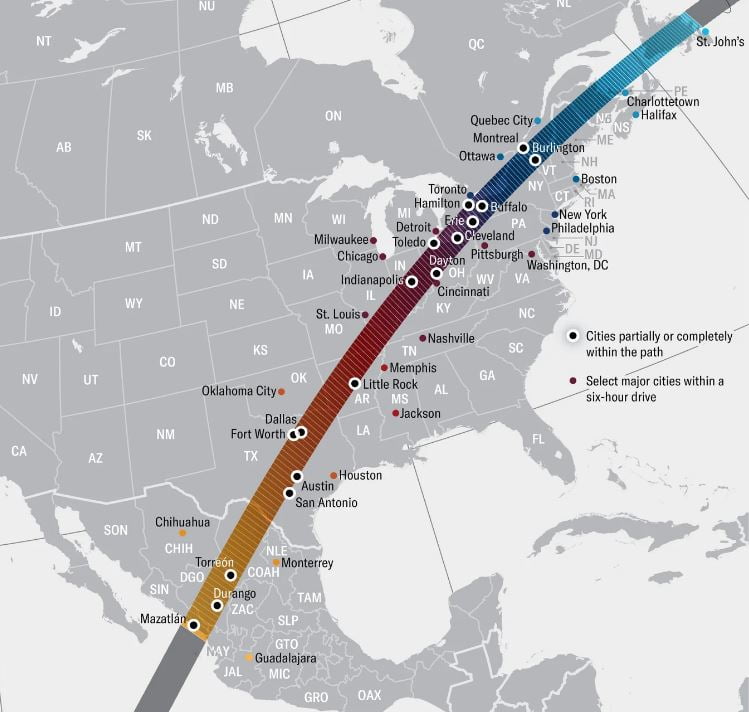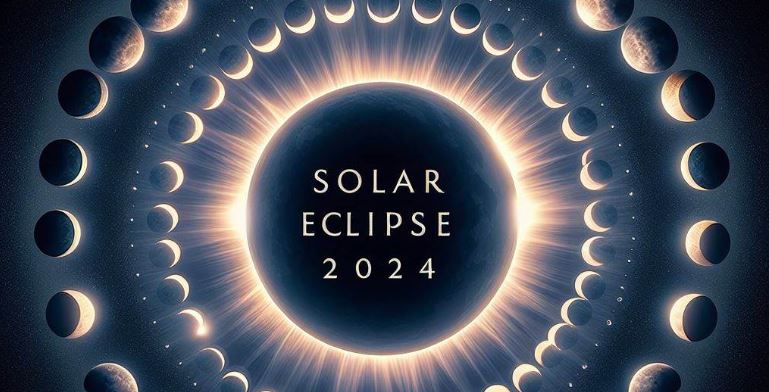Get ready to mark your calendars for the Total Solar Eclipse 2024, a cosmic event that will captivate millions across North America on Monday, April 8th, 2024. I’m talking about a prime cosmic event that will turn day into night across a huge stretch of North America. In this comprehensive guide, we’ll delve into everything you need to know about the Total Solar Eclipse 2024, from its significance to where and how to witness this awe-inspiring phenomenon.
It’s been almost 7 years since the Great American Eclipse in 2017 wowed millions by crossing the U.S. from coast to coast. Well, this upcoming eclipse promises to be even more amazing! The path of totality will be wider and the total eclipse will last nearly twice as long in some areas compared to 2017.
What is a Total Solar Eclipse?
Okay, let’s start with the basics. A total solar eclipse happens when the moon moves directly between the Earth and the sun. But this isn’t your regular full moon phase – the moon has to be just the right distance from Earth so it appears the same size as the sun in the sky.

When that cosmic alignment occurs, the moon fully covers the sun’s bright disk for up to a few minutes. During that brief period of totality, the sun’s outer atmosphere (called the corona) is suddenly exposed and visible as a glowing halo around the blacked-out sun. It’s an incredible, once-in-a-lifetime sight! This event will sweep across North America, treating spectators to a breathtaking display of nature’s grandeur.
Where and When is This Total Solar Eclipse 2024 Happening?
Mark your calendars for Monday, April 8th, 2024. That’s when the next total solar eclipse will race across a huge portion of North America during the daytime hours.
The path of totality (the roughly 115-mile wide path where the total eclipse happens) starts in the morning on Mexico’s Pacific coast. It then plows through central Mexico hitting cities like Mazatlán and Torreón before crossing into Texas around 1:30 pm local time.
From there, the totality path charges northeast over states like Arkansas, Missouri, Illinois, Indiana, Ohio, upstate New York, and into Canada’s maritime provinces before exiting off Newfoundland, Canada in the late afternoon. Crazy path, right?
How Long Will The Total Solar Eclipse 2024 Last?
This is where the 2024 eclipse really shines (pun intended)! Viewers situated right in the center of the totality path could experience over 4 minutes of the total eclipse at its peak. The maximum totality time of 4 minutes 28 seconds will occur near Nazas, Mexico.
To put that in perspective, during the heavily hyped 2017 eclipse across the U.S., maximum totality only lasted around 2 minutes 40 seconds. So we’re talking almost double the amount of time to experience totality in 2024! Eclipse chasers are already drooling over those extended minutes in the moon’s celestial shadow.
But keep in mind, that the duration of totality does vary quite a bit depending on your specific location along the path. It’ll be longest in Mexico and gradually shorten as the path curves northeast through the U.S. and Canada down to around 2-3 minutes near its endpoint. Either way, it’s still an incredibly generous total eclipse by cosmic standards.
| Location | Totality (local time) | Totality duration |
|---|---|---|
| Mazatlán, Sinaloa, Mexico | 11:07 a.m. MST | 4 minutes 20 seconds |
| Durango, Durango, Mexico | 12:12 p.m. CST | 3 minutes 50 seconds |
| Torreón, Coahuila, Mexico | 12:16 p.m. CST | 4 minutes 11 seconds |
| Piedras Negras, Coahuila, Mexico/Eagle Pass, Texas, U.S | 1:27 p.m. CDT | 4 minutes 24 seconds |
| Kerrville, Texas, U.S | 1:32 p.m. CDT | 4 minutes 25 seconds |
| Fredericksburg, Texas, U.S | 1:32 p.m CDT | 4 minutes 25 seconds |
| Dallas, Texas, U.S | 1:40 p.m. CDT | 3 minutes 52 seconds |
| Idabel, Oklahoma | U.S: 1:45 p.m CDT | 4 minutes 19 seconds |
| Russellville, Arkansas, U.S | 1:49 p.m. CDT | 4 minutes 12 seconds |
| Cape Girardeau, Missouri, U.S | 1:58 p.m. CDT | 4 minutes 7 seconds |
| Carbondale, Illinois, U.S | 1:59 p.m. CDT | 4 minutes 10 seconds |
| Bloomington, Indiana, U.S | 3:04 p.m. EDT | 4 minutes 3 seconds |
| Indianapolis, Indiana, U.S | 3:06 p.m. EDT | 3 minutes 51 seconds |
| Cleveland, Ohio, U.S | 3:13 p.m. EDT | 3 minutes 50 seconds |
| Erie, Pennsylvania | U.S: 3:16 p.m. EDT | 3 minutes 43 seconds |
| Rochester, New York, U.S | 3:20 p.m. EDT | 3 minutes 40 seconds |
| Montpelier, Vermont, U.S | 3:27 p.m. EDT | 1 minutes 42 seconds |
| Oakfield, Maine, U.S | 3:31 p.m. EDT | 3 minutes 23 seconds |
| Niagara Falls, Ontario, Canada | 3:18 p.m. EDT | 3 minutes 31 seconds |
| Montreal, Quebec, Canada | 3:26 p.m. EDT | 1 minute 57 seconds |
| Miramichi, New Brunswick, Canada | 4:34 p.m. ADT | 3 minutes 8 seconds |
| Tignish, Prince Edward Island, Canada | 4:35 p.m. ADT | 3 minutes 12 seconds |
| Catalina, Newfoundland, Canada | 5:13 p.m. NDT | 2 minutes 53 seconds |
Which is the best place to witness the Total Solar Eclipse 2024?
With a total eclipse lasting so long over heavily populated areas, this is sure to be one of the most-viewed eclipses in recent history. Both organized events and crowds of individual sky-watchers will likely flock en masse to locations inside the path of totality.
The burning question is…where exactly should you go to increase your odds of clear skies on eclipse day? According to forecasting models, the most promising destinations for good weather appear to be in Mexico and Texas. Cloud cover probability trends upward as the path extends northeast into the traditional “cloudbelts” of the Midwest and Northeast U.S.
Of course, those are just climatology probabilities based on historical data. The actual eclipse day weather remains impossible to predict until maybe a week in advance. So if you’re dead-set on witnessing totality, experts recommend having a flexible plan that allows you to adjust your viewing location based on those late short-term forecasts.

the best places to view the total solar eclipse of April 8, 2024, appear to be in Mexico and Texas. Here are some of the key details:
Mexico
- The path of totality first makes landfall in Mexico near Mazatlán on the Pacific coast around 11:07 am local time.
- The city of Nazas, near Durango, Mexico is expected to have the maximum duration of totality at 4 minutes 28 seconds.
- Other Mexican cities inside the path like Durango and Torreón will also experience over 3.5 minutes of totality.
- Mexico is highlighted as having the best odds of clear skies on eclipse day compared to other regions along the path.
Texas
- The path crosses into Texas around 1:30 pm local time near places like Eagle Pass and Piedras Negras, which will see around 4 minutes 24 seconds of totality.
- Cities like Kerrville and Fredericksburg in the Texas Hill Country are well-positioned for around 4 minutes 25 seconds of totality.
- The weather forecasting models show about a 50/50 chance of clear skies across Texas for the eclipse, giving it an edge over areas further northeast.
Other factors that make Mexico and Texas prime viewing locations:
- Being earlier along the path of totality means the eclipse happens higher in the sky compared to areas further east.
- The duration of totality gradually decreases from west to east after passing the point of maximum totality in Mexico.
- Eclipse-chasers often favor lower latitudes with milder/warmer April weather compared to regions further north.
No matter where you’ll be watching from, eclipse day should be an extraordinarily special event across all of North America.
Those in the path of Totality will get all the hype, but they aren’t the only ones in for an astronomical treat. On April 8th, every location across both North and Central America will experience at least a partial solar eclipse!
For skywatchers outside the path, the moon will appear to take a big “bite” out of the sun at the peak eclipse moments. Depending on your city, between 25-99% of the sun’s disk could be blocked by the moon…creating that eerie, alien-looking “crescent sun” in the daytime sky.
Major cities like Los Angeles, Phoenix, San Diego, Mexico City, New York, and Philadelphia all fall into this category of experiencing a deep partial eclipse. So no matter where you’ll be on April 8th, 2024, make sure you have approved solar eclipse glasses ready to safely view this cosmic spectacle.
Why should you watch the Total Solar Eclipse 2024?
Experts predict this eclipse will showcase an unusually large, dramatic corona around the blacked-out sun. That’s because the sun will be nearing its maximum activity level of its 11-ish year cycle in April 2024. The more active the sun is, the more its outer corona extends outward into space, creating a sort of crown around the eclipsed disk.
So if skies are clear on eclipse day 2024, viewers along the path of totality could be treated to a truly jaw-dropping celestial display unlike any in recent memory. All the more reason to get yourself positioned inside that path.
How to View the Eclipse Safely?
Before you embark on your eclipse-viewing adventure, it’s crucial to take precautions to protect your eyes from the sun’s harmful rays. Invest in certified solar eclipse glasses or solar filters for your camera or telescope to ensure safe viewing. Additionally, keep an eye on the weather forecast for your chosen viewing location and be prepared to adjust your plans accordingly. Remember, safety first—your eyes are precious, so take every precaution to safeguard them during the Total Solar Eclipse 2024.
Stock up on eclipse essentials, including eclipse glasses, sunscreen, and plenty of water, to ensure a comfortable viewing experience. Consider bringing along a camera or telescope equipped with solar filters to capture stunning images of the eclipse. And don’t forget to check local regulations and guidelines for viewing the eclipse safely and responsibly. With the right gear and a sense of adventure, you’re sure to have an unforgettable Total Solar Eclipse 2024 experience.
I don’t know about you, but I can barely contain my excitement thinking about this incredible cosmic experience!
Totality paths crossing straight through the heart of the continent…over 4 minutes of mid-day darkness in some areas…the beautiful corona and planets on display…it’s basically an eclipse chaser’s dream come true. And the best part? Millions upon millions of people across all of North America have a front-row seat to the celestial showstopper on April 8th, 2024.
So start finalizing those viewing plans and gathering your eclipse gear and you can find more info at NASA.






